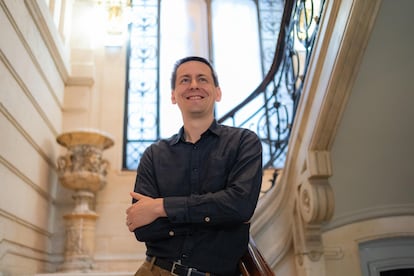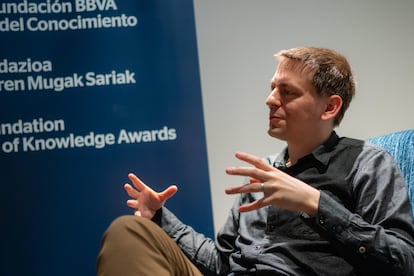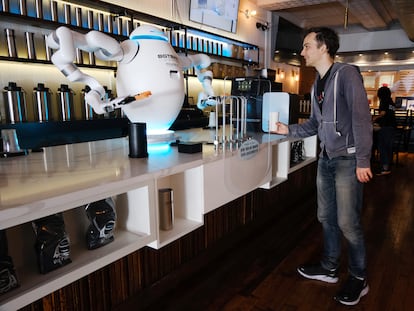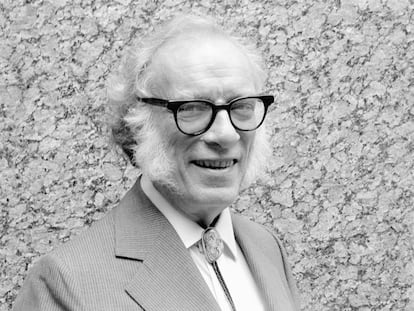John Jumper (DeepMind): ‘Drug development is stalled, mostly because we don’t understand how life works’
The recipient of the BBVA Foundation’s Frontiers of Knowledge Award recognizes the pressing need to consider the risks associated with artificial intelligence


Artificial intelligence (AI) is in the spotlight. Capable of producing progress and causing harm, AI’s very own champions are now sounding the alarm on its potential threats to humanity, and some have called for a pause in AI research. Yet, in the field of biology, AI recently solved one of our greatest enigmas: predicting the structure of all known proteins. It was a breakthrough that revolutionized biomedical research.
John Michael Jumper, a scientist at DeepMind, Google’s AI company, is one of the architects of this breakthrough. “The risks must be taken seriously, and we must be responsible,” he said, acknowledging the controversy over these technologies. Jumper didn’t say much more on the topic, even though his company’s CEO, Demis Hassabis, signed some of the cautionary manifestos about AI. Jumper, Hassabis and University of Washington researcher David Baker were recently awarded the BBVA Foundation’s Frontiers of Knowledge Award in Biomedicine for their contributions to AI-enhanced research on proteins. Their research led to a crucial breakthrough in understanding diseases and developing new pharmaceuticals.
DNA holds the instructions for life: guidelines for building proteins, the “machines” that enable any biological function, from breathing to thinking. But unlocking the secrets of each protein requires more than knowing its DNA sequence. You also need to know its shape, which is key to understanding how it behaves. For decades, scientists put their blood, sweat and tears into identifying these three-dimensional shapes. Only 200,000 protein structures were known, until Baker (RoseTTAFold), along with DeepMind’s Jumper and Hassabis succeeded in predicting the structures of 200 million proteins.
EL PAÍS interviewed Jumper at the BBVA Foundation’s headquarters in Bilbao (northern Spain), where he accepted his Frontiers of Knowledge Award at the presentation ceremony this past Tuesday. He says the enormous potential unlocked by his research is far greater than he ever imagined.
Question. It took scientists 60 years to identify the structure of 200,000 proteins. In just a few years, your team was able to solve the structure of 200 million — almost every known protein. What are the implications of this achievement?
Answer. To understand a protein, you have to know its structure. This has long posed a significant challenge for the scientific community. Before our project began, only 150,000 protein structures were known. This is expensive work. It can cost up to $100,000 per protein to understand its structure, and take a year or more of a PhD student’s time. However, the development of AlphaFold changed everything. Now, predicting protein structures takes seconds or minutes, accelerating scientific research faster than we ever imagined.
Q. How do I explain this to an audience unfamiliar with biology or artificial intelligence? Is it akin to a machine that can learn at hyper-speed, like a brain?
A. There are some similarities and differences in how machine learning and AI systems work versus how we learn. When you’re given a task in school, you do it and write down your answer. A teacher then checks your work for the right answer. If you’re correct, you feel good. If you’re wrong, you try to figure out what you should have done differently. When we learn, we make a lot of mistakes that we then correct and improve. This is somewhat similar to how we developed AlphaFold, a system that can predict a protein structure in seconds. We started with 200,000 known protein structures — correct answers, if you will. AlphaFold at first produced incorrect answers, but as we tweaked the system with an algorithm, it became progressively more precise and moved closer to the right answers. We moved on to the next protein, got the wrong answer, and improved it once again. It’s an iterative process of slowly adjusting the system to be more correct over a wide range of problems. Designing a system that accurately solves problems with known answers creates the potential for achieving accuracy with problems that don’t have known answers. You test, innovate and improve. It’s about making mistakes and correcting errors until you have a good system.
Q. The BBVA Foundation award panel said that your breakthrough is revolutionizing knowledge. Why do you think your research is groundbreaking? Is it because it saves time in biological research?
A. There are two reasons why AlphaFold is revolutionary. One is that we’ve already seen scientists use this technology to do incredible things, far beyond my expectations of how it would change biology and research. We’re seeing enormous innovation. But the broader reason is that this capability is comparable to how computational mathematical tools in the early 20th century helped us understand the complex world of physics. They helped us develop the transistor, which was the foundation for modern computers, which in turn facilitated computational and mathematical predictions. But biology is so complex that we can’t expect to solve problems with simple equations. It wasn’t clear what computational tools were the right ones and whether we could predict the outcome of experiments without actually performing them. AlphaFold shows that we’re approaching an era where we can predict many biological experiments. It’s the key to the broader, revolutionary goal of understanding the cell. This isn’t the end of the story. Perhaps it’s the beginning of understanding that machine learning and AI can be the tools that will help us solve these problems.
Q. What’s the next step?
A. We have two next steps. First, AlphaFold is an amazing system within a specific domain and we want to expand its capabilities to predict more things. We want to identify other problems in biology that can be addressed with machine learning. My team and I are driven by new challenges. I’m fascinated by how tiny molecules — proteins — function or fail to function, due to the genetic mutations that arise naturally. These are the questions that push us to expand our understanding of cells. The possibilities of this field motivate us to continue exploring, discovering, and studying this new realm.

Q. In an interview with the BBVA Foundation, you said that AlphaFold is a “powerful first example of how deep learning is able to capture the complexity of biological systems.” How much can they do? Are they like our brains?
A. Perhaps there are two answers here. First, we have shown that we can grasp the complexity of biological systems, but in a limited domain — protein structures. There are still many questions that AlphaFold cannot answer. Think about the human brain and all the reasoning we can do, yet no human is good at predicting protein structures unaided. It is not a human task, unlike many other AI developments like image and text recognition. It’s remarkable how machines can replicate human actions. It’s an example of how science can progress through experimentation. Working with AI to solve these intricate scientific problems brings an exciting edge to the challenge.
Q. What can AlphaFold do for us? Can it help create proteins to eradicate diseases like cancer?
A. Let me give you two examples. I’ll start with the [malaria] vaccine because it’s a very tangible example. Matt Higgins from Oxford aimed to create a vaccine in the short term that would train the body to recognize a pathogen. However, he faced the dilemma of identifying which part of the pathogen’s protein to use — he needed an accurate image of its structure. AlphaFold gave him that image, allowing him to choose the part to use for the vaccine.
Another example is the MIT research team that is currently tackling one of the biggest challenges in drug development: delivering protein-based medicine directly to where it’s needed, like in the case of cancer treatment. To accomplish this, the team is working on a molecular syringe, taking inspiration from bacterial systems that have the ability to inject foreign proteins into cells. By comprehending this intricate mechanism, they aim to revolutionize targeted drug delivery. The MIT researchers used AlphaFold to identify the protein and its entry point to cells; this may become an effective tool in fighting cancer. Complex diseases like Alzheimer’s may remain elusive for modern medicine to treat, but we will continue to strive for answers and solutions. Drug development is stalled because we don’t fully understand how the body works, how life works. We need biological research to understand it. Our current understanding is too limited to know precisely how to do it, but with AlphaFold, we have taken a giant stride towards reaching this goal.
Q. Since biology has an element of chance, what are the limitations of these systems?
A. While AlphaFold has accelerated experimentation in predicting protein structures, it’s important to note that this approach is not as precise as structures obtained through traditional methods of experimentation. It also addresses a small part of the vast field of biology and medicine. There are still many frontiers that require exploration and innovation. Our current progress is exciting, but there is still work to do.
We must take the risks of AI seriously and act responsibly.”
Q. Your research is a prime example of all the good that artificial intelligence can do for humanity, but many people are sounding warnings about its risks. Geoffrey Hinton, for example, a previous BBVA Foundation award winner. He left Google to talk about the dangers of artificial intelligence. What do you think? Are these concerns reasonable?
A. At DeepMind, our mission is not only to push the frontiers of technological innovation, but also to do so responsibly. We carefully weigh the ethical implications of our decisions before taking action. Take the release of AlphaFold, for instance. We knew we had a critical breakthrough on our hands, but we also knew that the implications extended far beyond the realm of simply enhancing scientific research. We recognized the need for a measured, cautious approach, and as such, we turned to over 30 biosecurity experts for counsel. With their invaluable insights, we were able to chart a path where we maximize benefits and minimize risks. In the end, we realized the best decision was to make AlphaFold open source. By distributing it widely, we can maximize the good it does and help as many people as possible. At DeepMind, we take our responsibility seriously and strive to be a force for good. Accountable AI development, considering short and long-term risks, has always been and will continue to be a priority. With our technology becoming more powerful, we don’t want to simply release it and see what happens. We must take the risks of AI seriously and act responsibly.
Q. Why are advocates of artificial intelligence, including your colleague Demis Hassabis, now signing their names to apocalyptic manifestos? How realistic are these risks of artificial intelligence for humanity?
A. I’m not sure what response you’re looking for here. I’ll say again that it’s crucial to consider the risks — they must be taken seriously and handled responsibly. As someone who’s familiar with biological contexts, I place a high value on doing things the right way. This includes carefully weighing the possibilities, considering the immediate and long-term risks, and evaluating potential impacts on society.
Sign up for our weekly newsletter to get more English-language news coverage from EL PAÍS USA Edition
Tu suscripción se está usando en otro dispositivo
¿Quieres añadir otro usuario a tu suscripción?
Si continúas leyendo en este dispositivo, no se podrá leer en el otro.
FlechaTu suscripción se está usando en otro dispositivo y solo puedes acceder a EL PAÍS desde un dispositivo a la vez.
Si quieres compartir tu cuenta, cambia tu suscripción a la modalidad Premium, así podrás añadir otro usuario. Cada uno accederá con su propia cuenta de email, lo que os permitirá personalizar vuestra experiencia en EL PAÍS.
¿Tienes una suscripción de empresa? Accede aquí para contratar más cuentas.
En el caso de no saber quién está usando tu cuenta, te recomendamos cambiar tu contraseña aquí.
Si decides continuar compartiendo tu cuenta, este mensaje se mostrará en tu dispositivo y en el de la otra persona que está usando tu cuenta de forma indefinida, afectando a tu experiencia de lectura. Puedes consultar aquí los términos y condiciones de la suscripción digital.










































